

In a major shift in the way Indians travel around the world, India recently joined the countries using biometric e-passports with chips. These include more than 120 countries, including the US, Canada, Mexico, Brazil, France, Italy, and Japan. This move marks a significant step forward in modernizing India’s travel documentation system and enhancing national security and convenience for international travelers. The e-passport, which contains a microchip storing biometric and personal data of the passport holder, is designed to streamline immigration processes, prevent identity fraud, and strengthen border security. The initiative is part of the "Passport Seva Program 2.0", launched in April 2024.
For the unversed, the E-passport was introduced in India in April 2024 under the "Passport Seva Program 2.0". Its testing was first done in some big cities like Nagpur, Bhubaneswar, Jammu, Goa, Shimla, Raipur, Amritsar, Jaipur, Chennai, Hyderabad, Surat and Ranchi. Now it is expected that it will be fully implemented across the country by mid-2025.
An e-passport is a next-generation passport in which a special chip (RFID chip) and antenna are installed inside the back cover. Important information of the passport holder, such as name, date of birth, passport number, photo, and fingerprints, are stored securely in this chip. All this information is coded in a special manner so that no one can read it easily. International security techniques have been used to keep this data safe, such as Basic Access Control (BAC), Passive Authentication (PA), and Extended Access Control (EAC).
Biometric e-passports have now become the new identity for safe and easy travel around the world. They have a small chip, which will instantly reveal your identity at immigration checkpoints. This makes it possible to cross the border quickly and without any manual check through e-gates. This will save you from standing in long queues and provide more convenience to the passengers. India's move towards e-passports is in line with the security standards of the International Civil Aviation Organization (ICAO). This will enable Indian passengers to avail of the same facilities that citizens of digitally advanced countries get. Also, this will further strengthen India's credibility at the global level.
After completing all the procedures from there, the e-passport will be sent to your address.